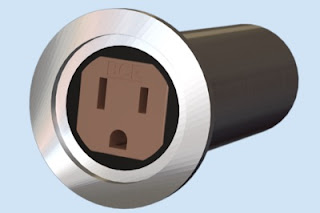Cartridge heaters fail because either the heat generated in the internal resistance wire is not efficiently dissipated or moisture (or a foreign substance) seeps inside the protective sheath, creating a short circuit.
Inadequate heat dissipation results in an elevated internal temperature, which can rapidly breakdown the heating element. Inadequate heat dissipation occurs for several reasons: when machined tolerances are outside of an accepted range (improper fit); if the watt density is too high; or when powered by too high a supply voltage.
1) Loose Fit
Loose fit is the most common cause of premature cartridge heater failure. The bore hole within which they are inserted must be held to tight tolerances. High watt density cartridge heaters are even more sensitive as the internal temperature of the heater can rise rapidly and jeopardize the life of the heating element. To ensure adequate thermal dissipation, the recommended hole diameter is no more than 0.002 in. greater than the nominal diameter of the heater.
Typical allowable watt densities for swaged cartridge heaters are based on fit and operating temperature.
 |
Max. allowable watt density vs. fit. Click image for larger view.
Graph courtesy of Backer Hotwatt. |
2) Too High a Watt Density
The watt density of the heater is vital to its performance. This is a measure of thermal power density and the higher the watt density, the greater the needs are for thermal dissipation. High watt densities can lead to premature failure when thermal dissipation needs are not met, as the internal temperature of the heater will exceed the limits of the resistive heating element.
3) Too High a Supply Voltage
In a resistive circuit, since the resistance is fixed, when the voltage is doubled, the current doubles as well as quadrupling the wattage output. Incorrectly specifying the supply voltage can lead to premature heater failure, as voltage has a dramatic effect on the wattage and the amount of heat generated as can be seen in the following formula.
4) Moisture or Contaminant Ingress
Even when cartridge heaters feature heliarc-welded end caps, they are prone to failure when the air surrounding the heater contains impurities or has a high moisture content and the heater’s leads are not adequately sealed. This is due to the nature of MgO insulation: it is a highly hydroscopic white powdered mineral, and when the heater undergoes thermal cycling a vacuum is created, drawing in moisture or other contaminants such as oil, which can result in internal shorting.
Watt Density Selection and Thermal Cycling
Suggested watt density is based on several factors including the fluid medium to be heated, the desired operating temperature and process variables such as flow rate. In general, operating temperature is inversely related to the suggested watt density. Additional considerations are taken when heating a fluid to a point near its boiling point, as phase changes drastically reduce its heat transfer capabilities. Highly viscous fluids or fluids that tend to coke or carbonize also require a low watt density. Highly corrosive solutions also need a low watt density, as the increased watt density increases the potential for corrosion, drastically reducing the life of the heater’s sheath.
Selecting an incorrect watt density can have adverse effects to the response of a thermal system, but it is not the only factor to consider. There are four basic elements to any thermal system, including the thermal load, the heat source, the heat transfer device and the temperature controller.
Thermal power delivered by a heating element is a function of wattage, and a correctly sized heating element will provide an ideal thermal response without rapid cycling of the element. The optimal wattage results in a 50/50 off/on cycle, which prevents or minimizes hunting or temperature overshooting. For more precise thermal control, variable voltage devices or solid-state controllers may be used.
For more information on properly applying cartridge heaters, contact
BCE by calling 510-274-1990 or by
visiting the cartridge heater section of the BCE website.
 BACKGROUND
BACKGROUND




